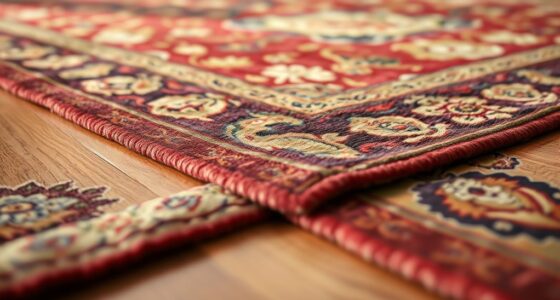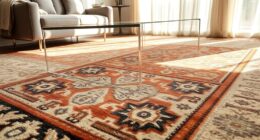To interpret a rug auction catalogue, start by understanding its layout, including section headings and lot numbers. Decipher catalog codes to learn about origin and style, and carefully review descriptions for materials, patterns, and condition. Observe images for color, repairs, and authenticity clues. Pay attention to pricing estimates and bidding terms to gauge value. With familiar terminology and careful analysis, you’ll gain confidence in evaluating rugs—continue exploring to master the details.
Key Takeaways
- Familiarize yourself with the catalogue’s sections, headings, and lot numbering system for efficient navigation.
- Learn to interpret lot numbers, catalog codes, and visual details to identify origin, size, and classification.
- Understand terminology related to materials, design motifs, and condition for accurate evaluation.
- Assess condition reports, provenance, and market value estimates to determine potential bidding strategies.
- Use additional resources like reference guides and seminars to enhance interpretation skills and market insight.
Understanding the Layout of the Catalogue
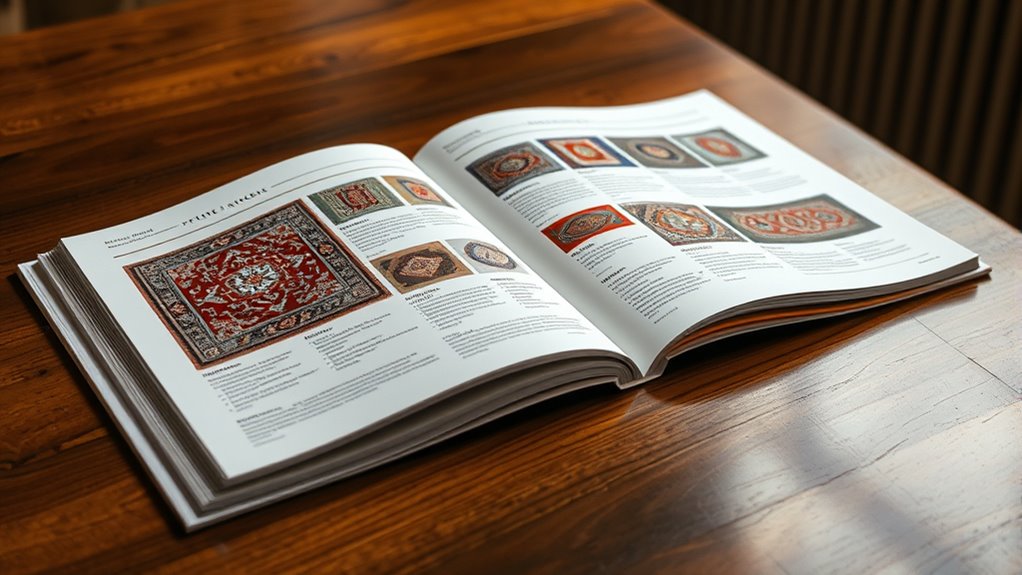
To effectively navigate a rug auction catalogue, you need to understand its layout. The catalog layout is designed to organize lots logically, making it easier to find what interests you. Usually, the catalogue is divided into sections based on rug types, origins, or styles, known as section organization. Each section begins with a heading that clearly indicates its focus. Within these sections, lots are listed sequentially, often with images, descriptions, and estimated prices. Familiarizing yourself with how the sections are organized helps you quickly locate specific rugs or categories. Pay attention to any introductory pages that explain the layout, as they provide valuable guidance on how the catalogue is structured. A clear understanding of this layout streamlines your viewing process and enhances your auction experience. Additionally, understanding the terminology used in the catalogue can further improve your ability to evaluate and select rugs of interest. Recognizing how different rug styles and origins are categorized can help you identify authentic pieces and avoid common pitfalls. Knowing the section organization can also assist in spotting trends or specific qualities of certain types of rugs, making your viewing more efficient. Being aware of the descriptive details included in each lot can further aid in your decision-making process. Gaining familiarity with rug classifications and their characteristic features can also improve your overall knowledge and confidence when bidding.
Deciphering Lot Numbers and Catalog Codes
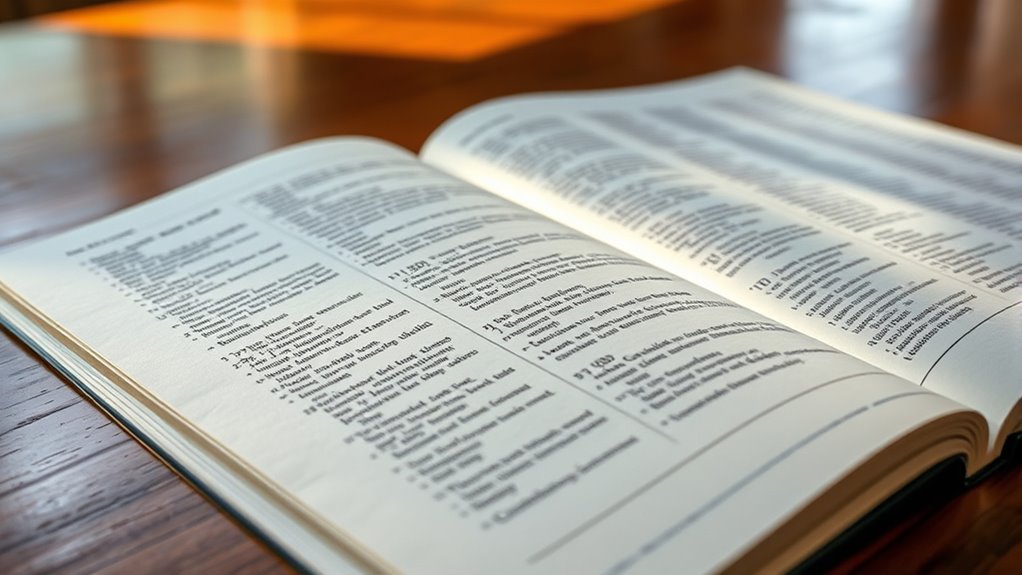
Once you’ve familiarized yourself with the catalogue’s layout, the next step is understanding how lot numbers and catalog codes identify each item. Lot number decoding helps you track specific rugs, revealing details like origin, size, and auction sequence. Catalog code interpretation involves deciphering alphanumeric combinations that categorize rugs by type, region, or period. To better grasp this, consider these key points:
Decode lot numbers and catalog codes to quickly identify rug origin, size, and classification details.
- Lot numbers often combine numbers and letters, indicating lot sequence and special features.
- Catalog codes use abbreviations and symbols to classify the rug’s origin, weave, or design.
- Recognizing patterns in these codes allows you to quickly assess a rug’s background and significance.
- Developing skills in catalog code interpretation can significantly enhance your ability to evaluate auction lots more efficiently.
- Understanding the significance of contrast ratios in projectors can help you visualize how different lighting conditions may affect the appearance of your chosen rug in a home theater setting. Additionally, familiarity with industry trends can provide insights into current market values and popular styles, enriching your overall appraisal skills.
- Being aware of the artistic influence of cultural symbols like butter can deepen your appreciation of traditional motifs and their historical contexts in rug designs.
- Moreover, studying home furnishings and their impact on interior aesthetics can give you a broader perspective when considering rug placement and display.
Mastering lot number decoding and catalog code interpretation makes your auction experience more informed and efficient.
Interpreting Descriptions and Terminology

Understanding the terminology in rug descriptions helps you identify key features quickly. You need to recognize terms related to materials, condition, and patterns to make informed decisions. Mastering these terms empowers you to interpret catalog details accurately and confidently. Additionally, familiarizing yourself with knowing dog names can enhance your overall experience when attending auctions or gatherings. Recognizing specific material types used in rug weaving can also give insights into the rug’s origin and value, further aiding your assessment. Developing an eye for detail can significantly improve your ability to differentiate between authentic and reproduction pieces, especially as knowledge of antique grading can influence a rug’s worth.
Deciphering Material Terms
Have you ever wondered what specific terms like “wool,” “silk,” or “cotton” really mean in a rug auction catalog? Understanding fiber types and dye sources helps you evaluate quality and authenticity. For example, knowing whether a rug is made from natural wool or a synthetic substitute impacts its value. Similarly, recognizing that vegetable dyes versus synthetic dyes influence color longevity and vibrancy is vital. Key points to consider include:
- Fiber types: distinguishes wool, silk, cotton, or blends
- Dye sources: natural (plant, insect) vs. synthetic
- Material finishes: hand-spun, machine-spun, or mixed fibers
Additionally, being aware of electric power generation methods, like bike generators, can help you understand energy efficiency and sustainability in the context of modern equipment. Understanding the AI technology used in evaluating and authenticating rugs can further enhance your buying confidence.
Understanding Condition Descriptions
When reviewing a rug auction catalog, carefully interpreting condition descriptions is essential for evaluating a piece’s true value. Pay close attention to details about fiber content, as it influences durability and age. For example, wool, silk, or cotton fibers each have different wear patterns and value implications. Additionally, note the dye types used—natural dyes often indicate older, more valuable rugs, while synthetic dyes may suggest modern or restored pieces. Condition descriptions may mention fading, repairs, stains, or wear, which affect a rug’s overall quality. Understanding these terms helps you assess a rug’s integrity and authenticity. Being precise in interpreting fiber content and dye descriptions guarantees you make informed decisions and avoid surprises during the auction.
Recognizing Pattern Terminology
Recognizing pattern terminology is key to accurately interpreting a rug auction catalog. When you understand the specific language used, you can better identify the rug’s design and style. Focus on pattern recognition and motif identification to distinguish between different regional or cultural origins. Look for clues in the descriptions, such as:
- Symmetry and layout: central medallions or all-over patterns
- Motif types: floral, geometric, animal, or abstract designs
- Border patterns: repeating bands or intricate framing elements
Recognizing Key Rug Attributes and Features
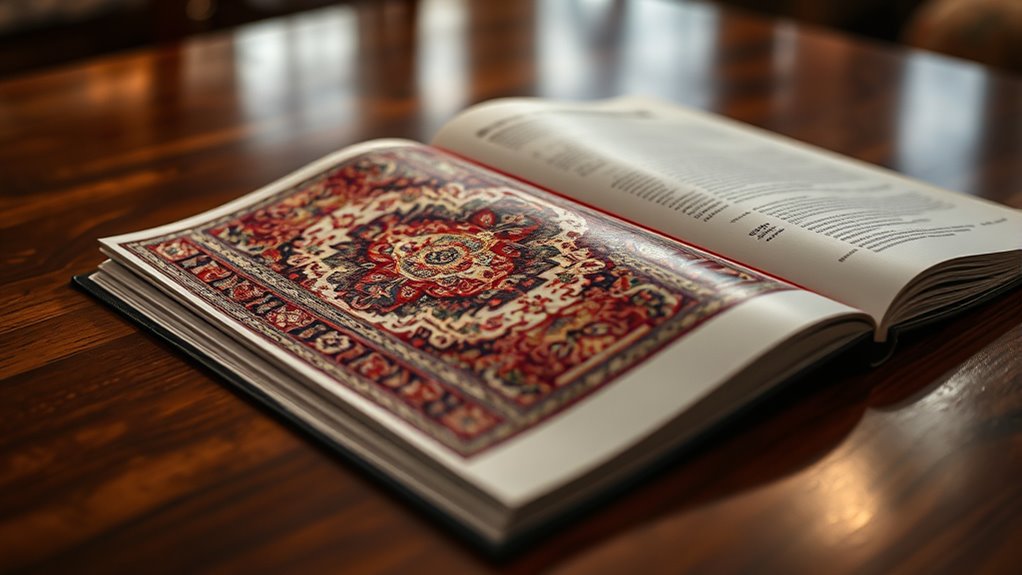
To understand a rug’s value, you need to recognize its key attributes and features. Look closely at the materials used, the knotting techniques, and the design patterns. These details reveal important information about the rug’s origin, craftsmanship, and age.
Identifying Rug Materials
Understanding the materials used in a rug is essential for evaluating its quality and authenticity. You can often identify these materials by examining the rug’s texture, sheen, and feel. Natural fiber rugs, like wool, silk, or cotton, tend to be softer, more breathable, and have a matte or subtle sheen. Synthetic fiber rugs, such as nylon or polyester, usually feel smoother, are more uniform, and often have a shiny appearance. To distinguish between them, look for these clues:
- Texture and softness
- Sheen and luster
- Feel and weight
Knowing whether a rug is made from natural or synthetic fiber can considerably influence its value, durability, and care requirements, helping you make informed bidding decisions.
Analyzing Knotting Techniques
Analyzing knotting techniques reveals important details about a rug’s craftsmanship and origin. By examining knotting variations, you can identify whether a rug uses Persian, Turkish, or other styles, each with distinct characteristics. For example, Persian knots typically have a symmetrical, flat appearance, while Turkish knots are asymmetrical and more textured. The weaving style also influences durability and texture, helping you distinguish high-quality pieces from lesser ones. Pay close attention to knot density, as higher knot counts often indicate finer craftsmanship. Understanding these key attributes allows you to assess a rug’s age, regional origin, and quality. Recognizing the differences in knotting techniques gives you a valuable edge when interpreting auction catalog descriptions and making informed purchasing decisions.
Recognizing Design Patterns
Examining the design patterns on a rug reveals a wealth of information about its cultural background and artistic influences. Recognizing key features like geometric motifs and floral patterns helps you identify origins and style periods. Look for repeating shapes, such as diamonds or hexagons, which often point to specific regions. Floral patterns, like rosettes or palmettes, can indicate influence from Persian or Mughal artistry. To deepen your understanding, consider these aspects:
- The symmetry and complexity of geometric motifs
- The naturalism or stylization of floral patterns
- The color palette used to enhance certain design elements
Evaluating Condition Reports and Wear Indicators
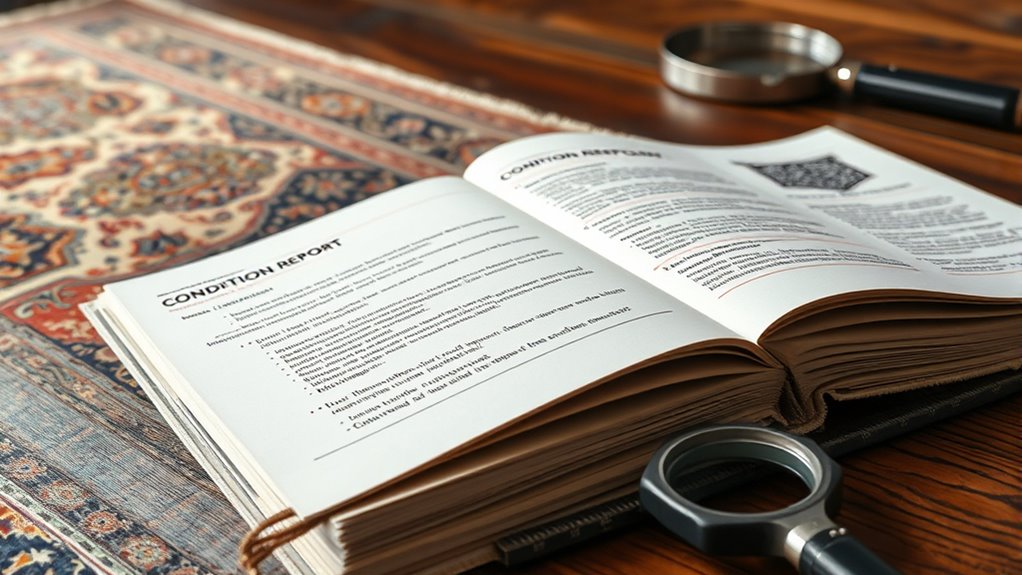
When reviewing condition reports, it’s essential to pay close attention to the details provided, as they offer crucial insights into the rug’s overall state and potential value. Check the fringe condition; frayed, missing, or repaired fringes can indicate heavy wear. Look for signs of dye stability—faded or uneven colors suggest age and authenticity, but excessive bleeding or inconsistent dye may point to poor quality or repairs. Note any visible repairs or patching that could affect durability and value. Be cautious of areas with significant wear, thinning, or stains, as these can impact the rug’s longevity. Understanding these wear indicators helps you assess whether the rug’s condition aligns with its price and provenance, guiding your buying decision confidently.
Analyzing Photographs and Visual Details
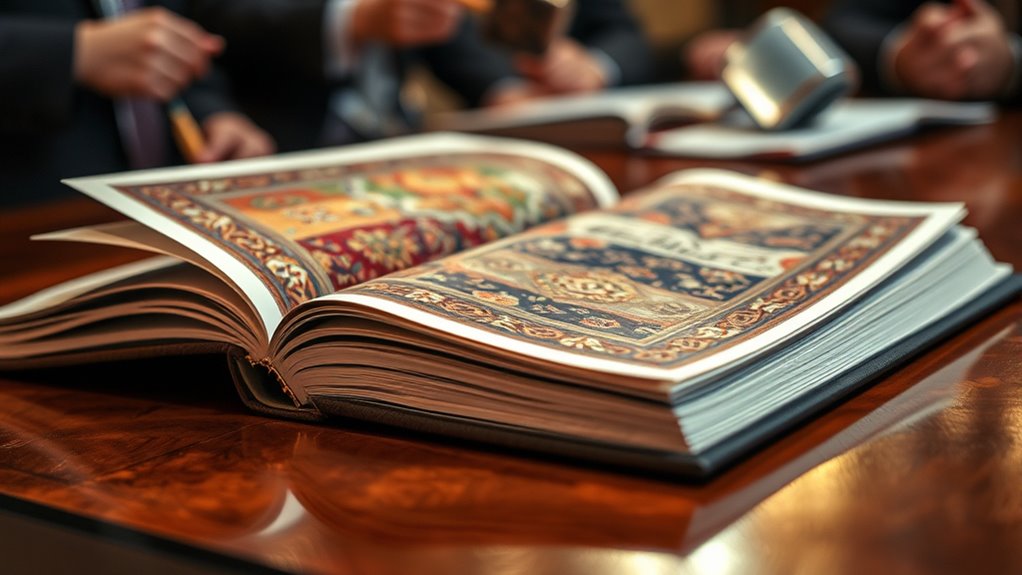
Photographs provide a vital window into a rug’s true condition and quality, often revealing details that may not be obvious in a written description. When analyzing these images, pay close attention to the color symbolism—certain hues can indicate a specific region or cultural meaning. Also, observe the cultural motifs woven into the design, which can reveal origins and artistic influences. To deepen your understanding, consider:
- The clarity and accuracy of color representation, noting any fading or repairs
- The prominence and placement of specific motifs that may hint at cultural significance
- The overall composition, symmetry, and craftsmanship reflected in the visual details
Carefully examining these elements helps you assess authenticity, origin, and the rug’s story beyond what words can convey.
Assessing Provenance and Historical Context
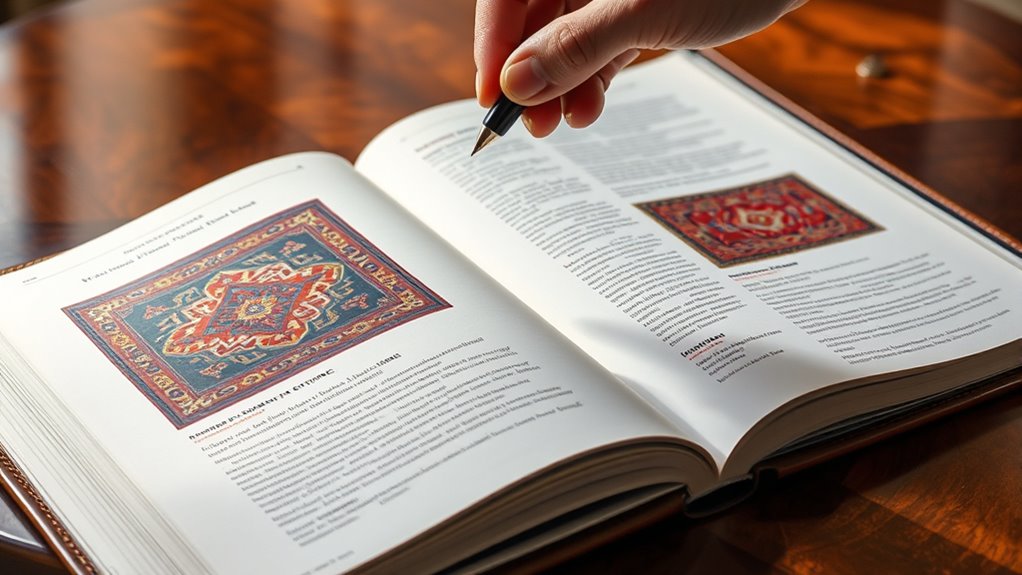
Understanding the provenance of a rug helps verify its origin and adds to its value. Look for documentation or markings that trace its history and production. You can also identify its significance by examining design features and consulting authenticity verification methods.
Provenance Documentation Importance
Why is provenance documentation so essential when evaluating a rug at an auction? It verifies the rug’s authenticity, helps confirm its antique identification, and provides a clear ownership history. Without proper provenance, you risk purchasing a reproduction or a piece with questionable origins. Provenance details can reveal previous sales, appraisals, or restorations that influence value. Additionally, it supports fiber analysis, ensuring the materials are consistent with the claimed age and region. This documentation gives you confidence in the rug’s background and authenticity, reducing potential for scams. When reviewing auction catalogues, always check for detailed provenance records—they’re your best tool for making an informed, secure purchase. Proper provenance documentation is your safeguard against misrepresentation in the art of rug collecting.
Historical Significance Indicators
When evaluating a rug’s provenance, paying attention to historical significance indicators can reveal its true importance beyond just its age or origin. Look for cultural symbolism embedded in the design, as certain motifs reflect the beliefs, traditions, or social status of its region. These historical motifs can offer insights into the period when the rug was created and its cultural context. For example, geometric patterns might signify specific tribal identities, while floral motifs could indicate a particular artistic tradition. Recognizing these elements helps you understand the rug’s story and historical importance. Such indicators connect you to the cultural heritage behind the piece, elevating its value beyond mere aesthetics and making it a meaningful artifact of history.
Authenticity Verification Methods
Authenticity verification methods play a vital role in confirming a rug’s provenance and historical context, ensuring that what you’re evaluating is genuine and not a reproduction. To do this effectively, look for authenticity markers such as unique weaving techniques, dye types, and material quality. Signature verification involves comparing the rug’s design elements or signature motifs with authenticated examples from specific regions or artisans.
Helpful strategies include:
- Examining weaving patterns and knot density for regional consistency
- Analyzing dyes for natural versus synthetic origins
- Cross-referencing signatures or motifs with verified provenance sources
These methods help you distinguish authentic pieces from forgeries, giving you confidence in your evaluation and potential purchase.
Grasping Pricing and Estimation Information
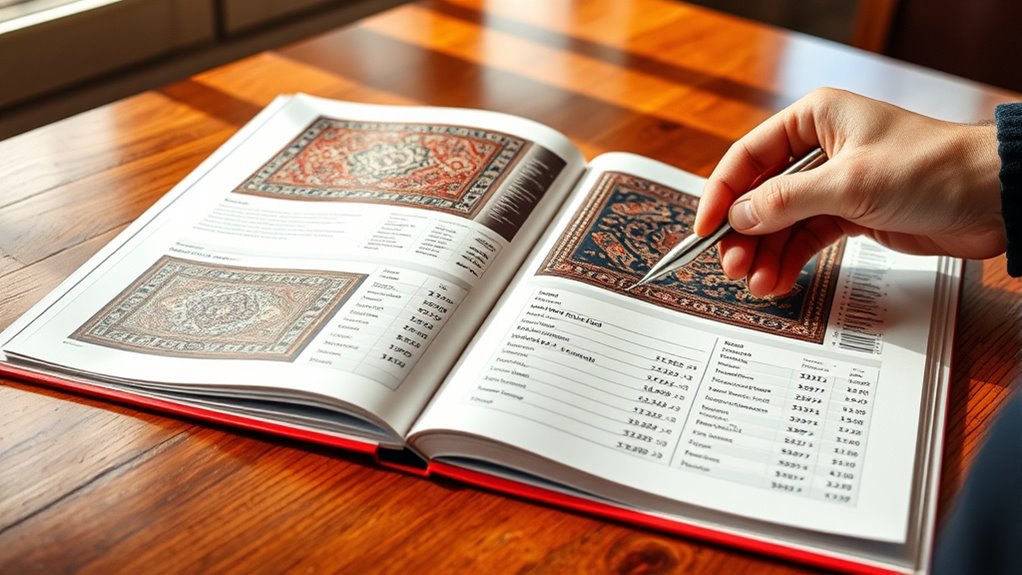
Understanding pricing and estimation details in a rug auction catalogue is essential for making informed bidding decisions. Price brackets help you quickly gauge the expected value of rugs, indicating low, mid, or high-range estimates. Pay attention to these brackets to identify pieces that fit your budget and desired quality. Estimation strategies involve evaluating factors like age, condition, origin, and craftsmanship to assess a rug’s worth accurately. The catalogue often provides approximate price ranges, but remember these are starting points for your own judgment. Comparing similar rugs within the same price brackets allows you to spot bargains or avoid overbidding. Developing a clear understanding of these details empowers you to bid confidently and avoid surprises during the auction.
Tracking Bidding and Sale Terms
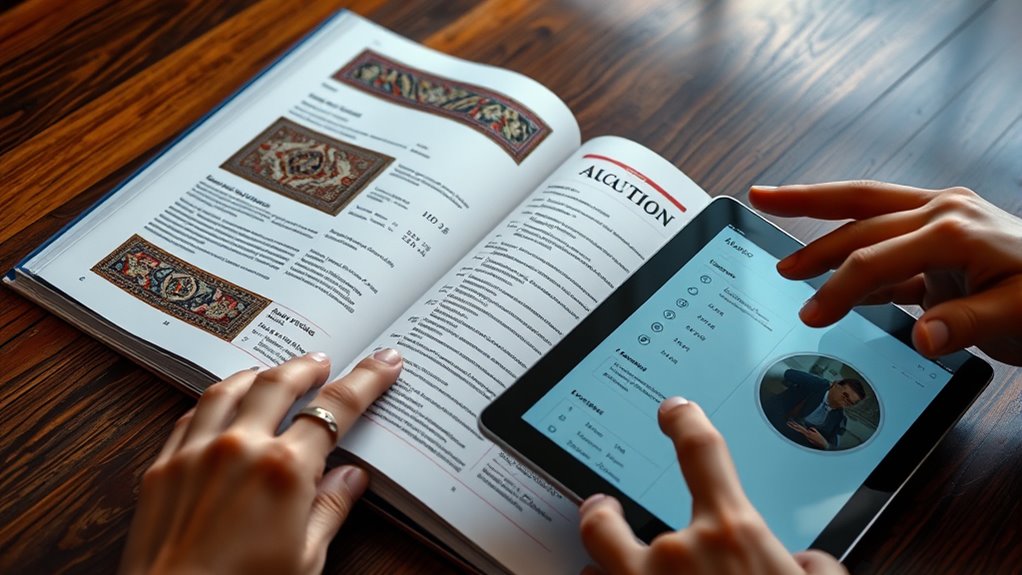
Keeping track of bidding and sale terms during a rug auction helps you stay on top of how the process works and avoid misunderstandings. Understanding the sale procedures and developing effective bidding strategies are key to success. Pay attention to auction-specific language, such as bid increments, reserve prices, and buyer’s premiums, which influence your bidding approach.
- Know when and how to place bids, whether in person, online, or by phone
- Recognize the auction’s rules for bid increments and maximum bids
- Clarify if the sale includes any additional fees or conditions before bidding
Utilizing Additional Resources and References

Have you ever wondered how to deepen your knowledge of rug qualities and market trends? Utilizing additional resources and references is key. Start by exploring books and online guides that explain auction terminology and cataloging standards. These resources help you interpret descriptions, classifications, and grading systems more accurately. Attend rug seminars or workshops offered by experts to gain firsthand insights. Many auction houses also provide reference catalogs or glossaries that clarify unfamiliar terms. Cross-referencing multiple sources guarantees you’re not relying solely on the auction catalogue, which can sometimes be inconsistent. By expanding your knowledge through reputable resources, you’ll become more confident in evaluating rugs, understanding market shifts, and making informed bidding decisions.
Frequently Asked Questions
How Do I Determine the Authenticity of a Rug From the Catalogue?
To determine a rug’s authenticity, start by examining the catalogue details closely. Look for notes on rug fiber analysis, which reveals genuine materials like wool or silk. Also, check if dye testing results are included, confirming the use of traditional or modern dyes. Be cautious of vague descriptions—authentic rugs often have specific provenance and craftsmanship notes. Combining these clues helps you confidently assess a rug’s authenticity before bidding.
What Are Common Pitfalls When Interpreting Auction Estimates?
Imagine you’re in a vintage arcade, but instead of games, you’re interpreting auction estimates. Common pitfalls include relying solely on estimate accuracy, which can be misleading if market trends shift unexpectedly. Don’t forget, estimates are just educated guesses; they don’t guarantee value. Be cautious of over-optimism or underestimating condition issues. Always compare lots and consider recent sales, ensuring you don’t fall into the trap of false security based on initial figures.
How Can I Identify Potential for Future Value Appreciation?
You can identify potential for future value appreciation by analyzing market trends and the rug’s historical significance. Look for pieces gaining popularity or increasing in price, which signals rising demand. Rugs with notable historical importance or unique craftsmanship tend to appreciate over time. Stay informed about auction results and expert opinions, as these insights help you spot rugs that may increase in value, making them smart investments for the future.
Are There Tips for Bidding Anonymously or Discreetly?
When you want to bid anonymously or discreetly, look for auction houses offering anonymous bidding options, such as sealed bids or online platforms with privacy features. Use paddle numbers instead of your name and avoid revealing personal details. You can also set maximum bids in advance to maintain discretion. Remember, communicating with the auction staff about your preferences guarantees your bidding stays private and discreet throughout the process.
How Do I Verify Auction Dates and Location Details?
You should always check the auction calendar for upcoming dates and confirm the venue details directly with the auction house. Look for official websites or contact their customer service to verify the auction location and schedule. Venue verification is essential to avoid mistakes. Keep an eye on updates, especially for online or postponed auctions, to guarantee you’re bidding at the right time and place.
Conclusion
By mastering each section of the catalogue, you become a skilled explorer journeying a treasure map of exquisite rugs. With keen eyes and confident steps, you’ll uncover hidden stories and true value behind every weaving. Think of the catalogue as a vibrant tapestry itself—each detail a thread guiding you toward your perfect piece. Embrace this knowledge, and soon you’ll dance effortlessly through auctions, turning pages into pathways to stunning finds.


